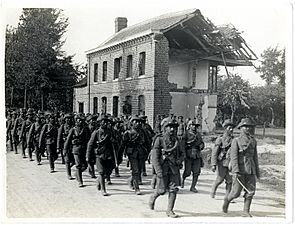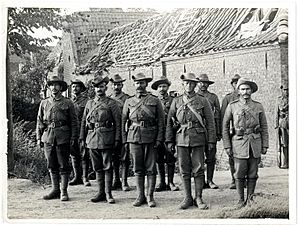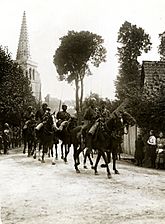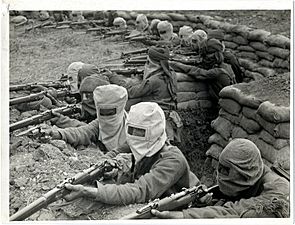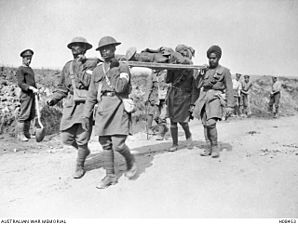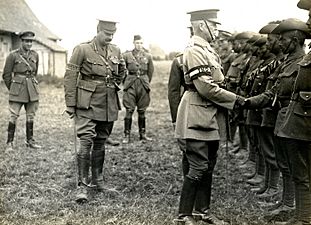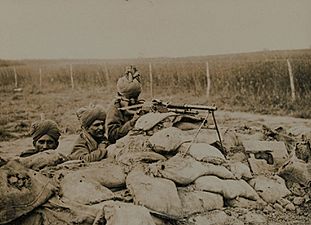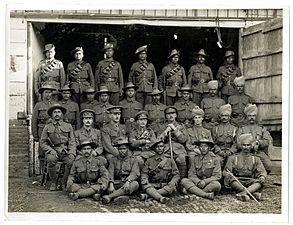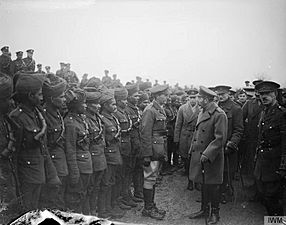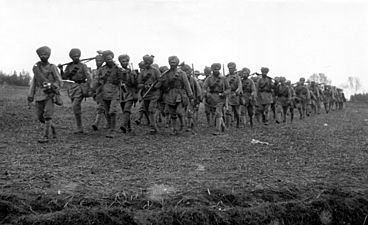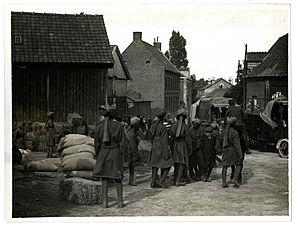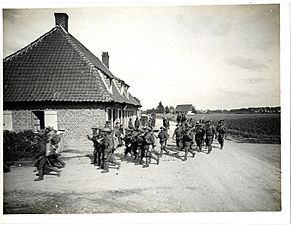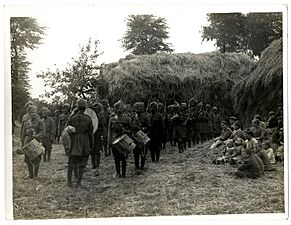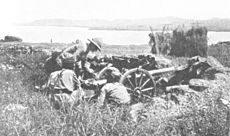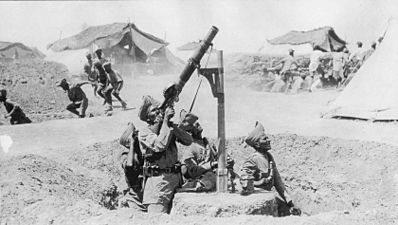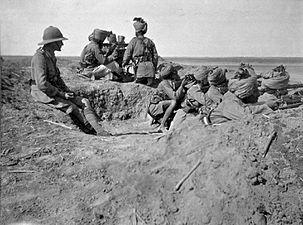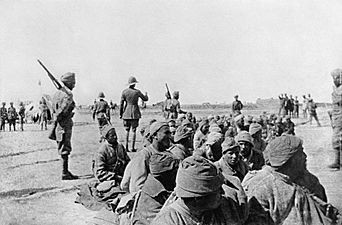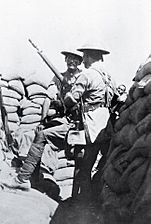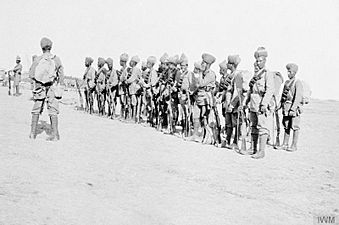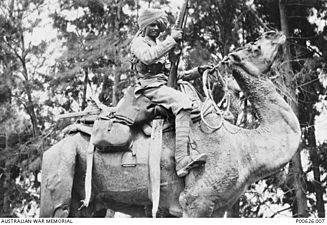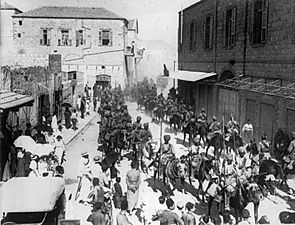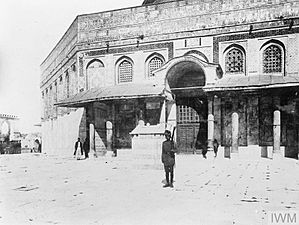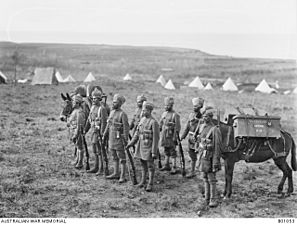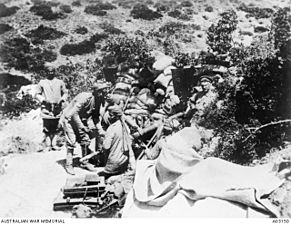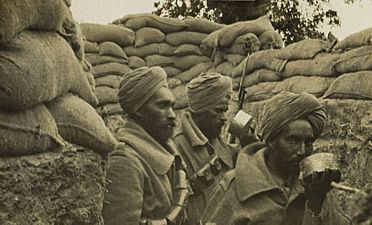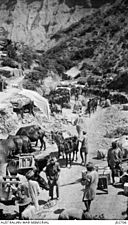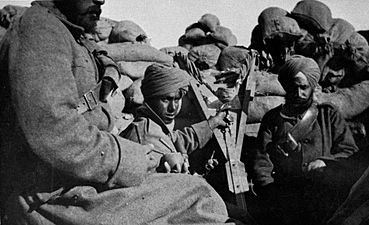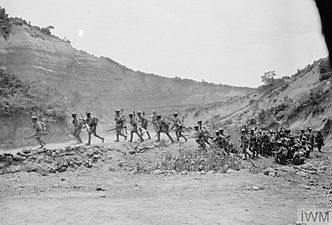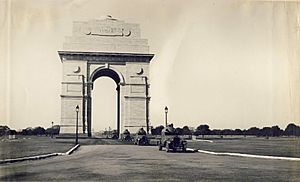Indian Army during World War I facts for kids
Quick facts for kids Indian Army |
|
|---|---|
 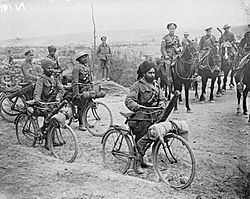
Indian bicycle troops at Battle of the Somme
|
|
| Active | 1895–1947 |
| Country | |
| Allegiance | |
| Type | Army |
| Size | 1,780,000 |
| Engagements | Second Boer War British expedition to Tibet World War I Waziristan campaign (1919–20) Waziristan campaign (1936–39) World War II |
| Commanders | |
| Notable commanders |
Herbert Kitchener, 1st Earl Kitchener |
The Indian Army was a very important part of the British Empire's military during World War I. More than one million Indian soldiers traveled overseas to fight. Sadly, about 62,000 of them died, and another 67,000 were wounded. In total, over 74,000 Indian soldiers lost their lives in the war.
The Indian Army fought against the German Empire on the Western Front in Europe. At the First Battle of Ypres, Khudadad Khan became the first Indian soldier to receive the Victoria Cross, a very brave award. Indian troops also served in places like Egypt, Gallipoli, German East Africa, and nearly 700,000 fought in Mesopotamia against the Ottoman Empire. Some soldiers stayed in India to guard the North West Frontier and help with training.
Claude Auchinleck, a top commander of the Indian Army, once said that Britain couldn't have won World War I and II without the Indian Army. This shows how vital their role was.
Contents
How the Indian Army Was Changed
Herbert Kitchener became the top commander in India in 1902. For five years, he worked to make the Indian Army stronger and more organized.
Kitchener's Big Reforms
Before Kitchener, there were three separate armies in India. He combined them into one single Indian Army. This made the army much more unified. Also, the armies from the many Princely states (local kingdoms in India) could now be called upon to help the main army. The British Army also had its own units serving in India. All these forces together were called the Army of India.
The new Army of India was set up with nine main divisions. Each division had one cavalry (horseback soldiers) and three infantry (foot soldiers) brigades. These divisions, plus some independent brigades, served across India. The Indian Army also had to provide troops for Burma and Aden.
Organizing the Troops
To make commanding easier, Kitchener created two main armies:
- The Northern Army covered the area from the North West Frontier all the way to Bengal. It had five divisions and three brigades.
- The Southern Army stretched from Baluchistan to southern India. It had four divisions in India and two groups outside India.
All the different regiments and battalions were given new numbers. The old names from the Bombay, Madras, and Bengal Armies were stopped. Soldiers could now be sent to serve anywhere in the country, not just near their homes.
The Indian Army's Strength
In 1914, the Indian Army was one of the largest volunteer armies in the world. It had about 240,000 men. By November 1918, its strength grew to over 548,000 men. It was seen as a key reserve force for the British Empire. The army often had to deal with attacks on the North West Frontier. It also provided soldiers for places like Egypt, Singapore, and China.
How Divisions Were Structured
The nine divisions created by Kitchener each had:
- One cavalry brigade (horseback soldiers).
- Three infantry brigades (foot soldiers).
A cavalry brigade usually had one British and two Indian regiments. An infantry brigade had one British and three Indian battalions. Indian battalions were smaller than British ones. They often had companies (smaller groups) made up of soldiers from different tribes, castes, or religions. Each division also had extra troops like a cavalry regiment, a pioneer battalion (engineers), and artillery.
Officers and Recruitment
The main headquarters for the army was in Delhi. Top leadership roles were shared between British and Indian Army officers. In 1914, each Indian battalion had 13 British officers and 17 Indian officers. As the war went on, it became hard to replace British officers who were wounded or killed. This meant fewer officers for some battalions. It wasn't until 1919 that Indian cadets could train to become officers at the Royal Military College.
Normally, the Indian Army recruited about 15,000 men each year. But during World War I, over 800,000 men volunteered to join the army. Another 400,000 volunteered for non-fighting roles. By 1918, almost 1.3 million men had volunteered for service.
Fighting at Home
Before World War I, the Indian Army mainly kept peace inside India. It also defended the North West Frontier from attacks by Afghanistan. These jobs continued even after the war began. Divisions like the 1st (Peshawar) Division, 2nd (Rawalpindi) Division, and 4th (Quetta) Division stayed on the frontier. The 16th Indian Division, formed in 1916, also served there. All these divisions later fought in the Third Afghan War after World War I ended.
India was also at risk from Afghanistan during the war. A German mission arrived in Kabul in 1915, trying to get Afghanistan to join the Germans. But the Afghan ruler, Habibullah Khan, kept his country neutral. Still, there were small fights along the frontier throughout the war.
On the North East Frontier, between India and Burma, troops fought against local tribes. This included actions against the Kachins in 1914-1915 and the Kuki tribes in 1917-1919.
Other divisions stayed in India for internal security and training. These included the 5th (Mhow) Division, 8th (Lucknow) Division, and 9th (Secunderabad) Division. Over time, parts of these divisions were sent to fight overseas.
Joining the War Effort
In 1901, oil was found in Persia (modern-day Iran). This oil was very important for fueling the British Navy. When the Ottoman Turkish Army started to mobilize in 1914, Britain worried about the oilfields. The Indian government was told to make plans to protect them.
Indian Expeditionary Force D
The first Indian troops sent to protect the oilfields were part of Indian Expeditionary Force D. They sailed from Bombay in October 1914 to Bahrain. They were the first Indian soldiers to fight outside India in World War I.
Independent Brigades
The Indian Army also formed special independent brigades. The Aden Brigade protected a key naval route. The Bannu Brigade, Derajat Brigade, and Kohat Brigade guarded the North West Frontier. The South Persia Brigade was formed in 1915 to protect British oil sites in southern Persia.
Indian Expeditionary Forces Overseas
The Indian Army sent seven large forces, called Expeditionary Forces, to fight overseas during World War I.
Indian Expeditionary Force A: The Western Front
When the war started, India offered two cavalry and two infantry divisions for overseas service. This force, called Indian Expeditionary Force A, went to France. It arrived in Marseilles in September 1914, just six weeks after the war began. They were quickly sent to the Ypres Salient and fought in the Battle of La Bassée.
Indian soldiers faced many challenges in France. They were not used to the cold European weather. They also had new equipment and very little artillery. This made fighting difficult. Many officers were lost, and new ones didn't know the Indian Army or its languages. Because of these problems, the infantry divisions were moved to Mesopotamia in October 1915.
The two Indian cavalry divisions stayed on the Western Front. They fought in major battles like the Battle of the Somme and the Battle of Cambrai. Sometimes, they even fought in the trenches as foot soldiers. In March 1918, they were moved to Egypt. Out of 130,000 Indians who served in France and Belgium, almost 9,000 died.
-
Indian Cavalry on the Western Front
-
Indian Cavalry marches through Estrée-Blanche
-
Indian infantry with gas masks in trenches near Fauquissart
-
Indian soldiers evacuate wounded officer on stretcher near Ginchy
-
Indian troops en route to relieve French and American units in the German spring offensive
-
2nd Rajput Light Infantry in action in Flanders
-
15th Sikhs in Marseille on their way to fight the Germans
-
2/2 Gurkhas, 9th Gorkhas and 6th Jats who received honours or were mentioned in dispatches, Saint-Floris
-
King George V inspects Indian troops at Le Cateau
-
Soldiers of the 129th Baluchis in Flanders. The Kullah or conical top was typically worn by Punjabi Muslim soldiers
-
129th Baluchis near Hollebeke, Belgium during the First Battle of Ypres in October 1914
-
Typical Baluchi riflemen (Estaires-La Bassée Road, France), 4 Aug 1915
Indian Expeditionary Force B & C: East Africa
In 1914, the British governor of British East Africa asked for help against German forces there. India sent two forces. Indian Expeditionary Force B landed at Tanga in November 1914. This force of 9,000 men was badly defeated by a much smaller German force. They suffered heavy losses and had to leave.
Indian Expeditionary Force C was the second force sent to East Africa. It was meant to defend railways and support local troops. This force was broken up, and its units served separately. They were involved in the Battle of Kilimanjaro in October 1914. Despite having more men, they faced strong German defenses and had to retreat.
Indian Expeditionary Force D: Mesopotamia
The largest Indian Army force sent abroad was Indian Expeditionary Force D in Mesopotamia (modern-day Iraq). The first unit, the 6th (Poona) Division, arrived in November 1914 to guard British oil facilities. They had some early successes, but then faced problems at the Battle of Ctesiphon.
After this battle, the Poona Division retreated to Kut. The commander decided to hold the city, leading to the Siege of Kut. For months, the troops were trapped and suffered from disease. In April 1916, they had to surrender. Later, in 1917, a new British force with many Indian Army divisions advanced and captured Baghdad. The campaign continued until October 1918, when Turkish forces surrendered. The Mesopotamia campaign was mostly fought by the Indian Army. Over 11,000 Indian soldiers were killed, and many more died from wounds or disease.
-
Indian anti-aircraft gunners at Battle of Sheikh Sa'ad
-
Indian troops march into Baghdad
-
37th Indian Brigade in Basra
Indian Expeditionary Force E: Sinai and Palestine
Indian Expeditionary Force E started with the 22nd (Lucknow) Brigade sent to Egypt in October 1914. Later, two Indian cavalry divisions from France joined them in Palestine in 1918. They were also joined by the 15th Imperial Service Cavalry Brigade, made up of regiments from Indian princely states. Many Indian army battalions were also sent to strengthen British divisions there.
-
Indian Cavalry at Aleppo
-
Jodhpur and Mysore lancers march through Haifa
-
Indian Army outside Jaffa Gate, Jerusalem
-
Indian sentry guards Dome of the Rock, Jerusalem
-
Indian Cavalry enters Damascus
Indian Expeditionary Force F: Suez Canal Defense
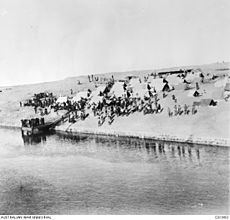
Indian Expeditionary Force F included the 10th Indian Division and the 11th Indian Division. Both were formed in Egypt in 1914 to defend the important Suez Canal. Other units, like the 22nd (Lucknow) Brigade, were also attached. Many of these divisions and brigades were later broken up or sent to other battlefronts.
Indian Expeditionary Force G: Gallipoli Campaign
In April 1915, Indian Expeditionary Force G was sent to help in the Gallipoli Campaign. This force was the 29th Brigade, made up of Gurkhas and Sikhs. They were sent from Egypt to help the British 29th Division, which had suffered many losses.
The 29th Brigade played a big part in the Third Battle of Krithia. They advanced bravely, but faced strong resistance. The 14th Ferozepore Sikhs were almost completely wiped out in Gully Ravine. The brigade also fought in the Battle of Gully Ravine and the Battle of Sari Bair. After suffering many casualties, the brigade was moved back to Egypt. Over 16,000 Indian troops served in Gallipoli, and about 1,600 died.
-
29th Indian Brigade land at Cape Helles
-
Indian and Anzac troops at Anzac Cove
-
Gurkha Battalion charges through Gully Ravine
Other Important Actions
Siege of Qingdao
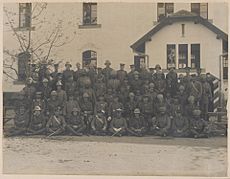
One Indian Army battalion, the 36th Sikhs, took part in the Siege of Qingdao in China. Qingdao was a German-controlled port. A small British force, including the 36th Sikhs, joined Japanese troops to capture the port. The siege lasted from October to November 1914. The British-Indian forces had 12 killed and 53 wounded.
1915 Singapore Mutiny
The 1915 Singapore Mutiny involved some Indian soldiers of the 5th Light Infantry in Singapore. These soldiers had arrived from Madras in 1914. Rumors spread that they would be sent to fight against fellow Muslims from the Ottoman Empire. On February 16, 1915, some soldiers mutinied. They killed British officers and civilians. The mutiny lasted for about five days before it was stopped by other troops. After the mutiny, 47 soldiers were executed, and many others were imprisoned.
1918 Malleson Mission
About 500 men from the 19th Punjabis were sent to Transcaspia (Central Asia) in 1918. This was called the Malleson Mission. They supported a group fighting against the Bolsheviks (Communists) in Russia.
Brave Soldiers: Victoria Cross Winners
Before 1911, Indian soldiers could not receive the Victoria Cross (VC), which is Britain's highest award for bravery. Instead, they received the Indian Order of Merit. But during World War I, this changed.
The first Indian soldier to win the Victoria Cross was Khudadad Khan of the 129th Duke of Connaught's Own Baluchis. In October 1914, in Belgium, he kept firing his machine gun even after being wounded and all his comrades were killed. He held his position bravely.
Other Indian Army members who won the Victoria Cross during World War I include:
- Darwan Singh Negi, 39th Garhwal Rifles
- Lt. Frank Alexander de Pass, 34th Prince Albert Victor's Own Poona Horse
- William Bruce, 59th Scinde Rifles
- Eustace Jotham, 51st Sikhs
- Gabar Singh Negi, 39th Garhwal Rifles
- Mir Dast, 55th Coke's Rifles (Frontier Force)
- John Smyth, 15th Ludhiana Sikhs
- Kulbir Thapa, 3rd Gurkha Rifles
- Lala, 41st Dogras
- John Alexander Sinton, Indian Medical Service
- Shahamad Khan, 89th Punjabis
- Gobind Singh, 28th Light Cavalry
- Karanbahadur Rana, 3rd Gurkha Rifles
- Badlu Singh, 14th Murray's Jat Lancers
These brave soldiers showed incredible courage and self-sacrifice in battle.
What Happened Next
After World War I ended in 1918, the Indian Army still had about 491,000 men. However, there was a shortage of experienced officers. In 1921, the Indian government began to review its military needs. Their main goals were to protect the North West Frontier and maintain peace within India.
By 1925, the Army in India was reduced to 197,000 troops, with 140,000 of them being Indian soldiers. The army was reorganized into different roles:
- A field army for fighting.
- Covering troops to act as a reserve force.
- Internal security troops to help civil authorities.
The number of cavalry regiments was cut, and infantry regiments were combined into larger groups.
Even after World War I, the Indian Army continued to be involved in conflicts. They fought in the Third Afghan War in 1919 and several campaigns in Waziristan throughout the 1920s and 1930s.
The India Gate in New Delhi, built in 1931, is a famous monument. It honors the 70,000 Indian soldiers who died fighting in World War I.
See also
- Indian Army (1895–1947)
- Indian Labour Corps
- Defence of India Act 1915
- Indian Army during World War II



